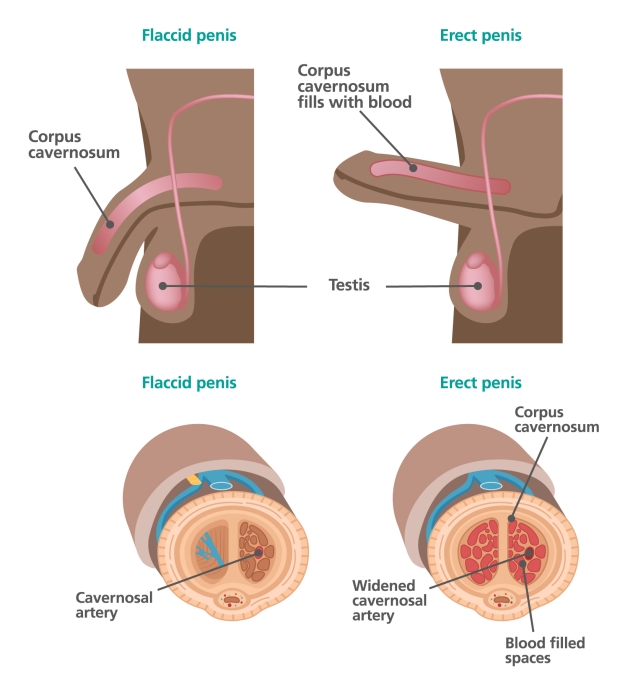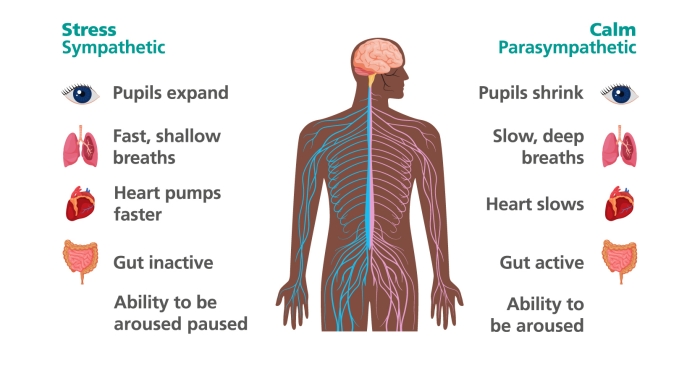When you are aroused, chemical messages and hormones are sent around your body which allow physical changes to take place such as:
- your heart rate and blood pressure increase
- blood flows to your genitals
- your muscles tense
- your heart beats faster
- your breathing becomes faster and deeper
Increased blood flow means your genitals become more sensitive to touch and your testicles may pull up tighter to your body. The increased blood flow to the penis allows the corpus cavernosum to fill with blood, which supports to the penis to become erect.
The image below shows some of these physical changes:

These physical changes prepare your body for sexual contact, and can make touch feel comfortable and enjoyable. It is important that you give your body time to respond during the arousal process, so that you do not feel any discomfort during a sexual experience. It is also important that you feel confident talking about this with your sexual partners so they understand and can respond to your feedback about how turned on you feel.
If anything gets in the way of the arousal process, then these physical changes may not happen and your body will not be prepared for sex.
The impact of anxiety on arousal
The arousal process is controlled by a part of the nervous system called the parasympathetic nervous system (PNS), which is an involuntary, or automatic, system that is active when our mind and body is in ‘calm’ mode.
There is another system in the body, called the sympathetic nervous system (SNS), which works in opposition to the PNS - when one is in control, the other closes down. The SNS controls the brain and body when we feel stressed, anxious, or in danger (in ‘stress’ mode). This is sometimes called the ‘fight or flight response’.
When the flight or fight response is activated, it sends blood to the muscles we need to run or fight (for example, our arms and legs) and shuts down all non-essential functions that we wouldn’t need if we were in danger, including the arousal system.
The diagram below demonstrates the impact these two systems have on the body:

The fight or flight response can kick in for both real or perceived/imagined threats, meaning that worrying about something is enough to trigger these physical changes in our bodies. As shown in the diagrams, the body has to be relaxed (or in ‘calm’ mode) in order to become sexually aroused. When you’re anxious or worried (whether about being in a sexual situation or about anything else), your body switches into ‘stress’ mode which pauses the arousal system.
The harder you try to get an erection, the less likely it is you will get one because of the stress of trying. That said, while erections are largely involuntary, you can do things to trigger them.
People can and do get erections without necessarily being sexually aroused in the sense of feeling desire, for example first thing in the morning, in situations of danger, or when their penis is being physically stimulated.
If you’ve been having problems getting erections, you may feel you need to use any erection you get as quickly as possible, before it disappears again. This is usually a mistake, as it puts you (and your penis) under pressure, which can set up patterns of performance anxiety and problems getting erections.
The image is a medical diagram - the impact of the ‘Stress’ or Sympathetic Nervous System and the ‘Calm’ or Parasympathetic Nervous System on the body.
The labels for the 'Stress' system include:
- pupils expand
- fast, shallow breaths
- heart pumps faster
- gut inactive
- and ability to be aroused is paused
The labels for the 'Calm' system include:
- pupils shrink
- slow, deep breaths
- heart slows
- gut active
- and ability to be aroused